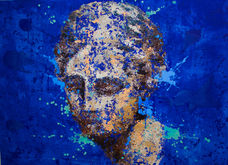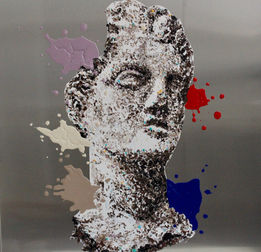impop
arrigo musti
IMPOP
ARRIGO
MUSTI
Annabelle Priestley
Despite the apparent chaotic application of paint, Musti’s precise dripping technique leaves little space for chance. Each figure is the accurate reproduction of Greek sculptures statues he photographed in Sicily, while the colorful patterns are inspired by the Arabo-Roman art and architecture designs found in his native island. These elements of a glorious past, blend to form a beautiful whole. Yet, tension is perceptible. In this series, bright swirls of color shake the thousand-year-old statues out of their stupor. They wake up in a world in which humankind seems to have lost his mind. In their race for economic performance and material illusions, civilizations forget about their past and jeopardize their future. Musti’s paintings are a direct comment on the current state of our planet endangered by warfare and ecological disasters, leading to human suffering and destruction of cultural heritage. As old myths are falling apart, Musti’s paintings call for the creation of new meaningful ones.
Annabelle Priestley is a curatorial assistant at the Princeton University Art Museum. She has an M.A in Contemporary and Modern Art and its Markets from Christie’s Education in New York.
At the Princeton University Art Museum, she put up the exhibition Women Artists and Abstraction and carried on preliminary research for several other exhibitions at the museum, including Joseph Albers: Formulation and Articulation, Time Capsule, 1970: Rauschenberg’s Currents, and Color and Motion.

ORIGIN
serie
Mark Jenkins
Musti applies paint by dripping rather than brushing, and he incorporates lace, thread and other materials into his work. The bright colors and loose gestures appear contemporary, but most of the images are modeled on ancient Greek and Roman frescoes and mosaics. From a distance, the layers and textures suggest artworks made with clay and plaster and damaged by millennia of wear. Seen up close, however, Musti’s pictures reveal a randomness that is anything but classical.
THE WASHINGTON POST

MYTH
serie
Lorenzo Canova
With his most recent work, based on pictures with very bright colours, on almost lysergic weavings and on quotations of Greek and Roman sculpture, Arrigo Musti paradoxically converses with the real face of classicism rediscovering its mixtures and contaminations and giving new life to that colour that today we seem to have forgotten in our distorted vision of completely white antiquity...
As Maurizio Calvesi taught his students, making a comparison between Caravaggio and Guttuso, often con- temporary art is also useful to us to understand the art of the past centuries and Musti, in this case, helps us to understand and see the lost face of ancient statues, to find once again the memory of their polychromy, to rediscover that colour that enlivened them, which time has taken away, chilling the features of works that wanted to have absolute (hyper)realism, harmonizing themselves, in their desire for imitation, with the variety of the colours of the world. Arrigo Musti is nevertheless aware that that colour is now lost and that its evocation can become animated as a dream or a vision, in the elegy for an antiquity that we can only imagine today, as if the time of clocks was interrupted and there opened up in front of us the original spectacle, in a sort of eternal return where we find once again the perfume of millennial flowerings and where the gods smile at us and dance, reborn and reappearing from the unexplored lands of the unconscious.
Lorenzo Canova
(Rome 1967), art historian, curator and art critic.
PhD in Art History at La Sapienza University in Rome, he is an associate professor of History of Contemporary Art at the Department of Humanities, Social Sciences and Education of the University of Molise.
He deals with modern and contemporary art, with particular attention to sixteenth-century art, art in the second half of the twentieth century and the art of the latest Italian and international generations.
He has handled exhibitions in Italian and international museums and public spaces.
He is the founder and director of ARATRO – Archive of Electronic Arts - Laboratory for Contemporary Art, University of Molise, Campobasso. He is a member of the scientific council and board of the Giorgio e Isa de Chirico Foundation.





























































